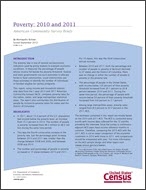
An official website of the United States government
Here’s how you know
Official websites use .gov
A .gov website belongs to an official government organization in the United States.
Secure .gov websites use HTTPS
A lock (
) or https:// means you’ve safely connected to the .gov website. Share sensitive information only on official, secure websites.
-
//
- Census.gov /
- Publications /
- Poverty: 2010 and 2011
Poverty: 2010 and 2011
Poverty: 2010 and 2011
Introduction
The poverty rate is one of several socioeconomic indicators used by policy makers to evaluate economic conditions. It measures the percentage of people whose income fell below the poverty threshold. Federal and state governments use such estimates to allocate funds to local communities. Local communities use these estimates to identify the number of individuals or families eligible for various programs.
This report, using income and household relationship data from the 1-year 2010 and 2011 American Community Surveys (ACS), compares poverty rates for the nation, states, and large metropolitan statistical areas. The report also summarizes the distribution of people by income-to-poverty ratios for states and the District of Columbia.
Highlights
- In 2011, about 15.9 percent of the U.S. population had income below the poverty level, an increase from 15.3 percent in 2010. The number of people in poverty increased from 46.2 million to 48.5 million during the same time period.
- This was the fourth consecutive increase in the poverty rate, but the percentage point increase between 2010 and 2011 was smaller than the change between 2008 and 2009, and between 2009 and 2010.
- The number and percentage of people in poverty increased in 17 states between 2010 and 2011. For 10 states, this was the third consecutive annual increase.
- Between 2010 and 2011, both the percentage and number of people in poverty in Vermont declined. In 27 states and the District of Columbia, there was no change in either the number of people in poverty or the poverty rate.
- The percentage of people in the United States with income below 125 percent of their poverty threshold increased from 20.1 percent to 20.8 percent between 2010 and 2011. During the same time period, the percentage of people with income below 50 percent of their poverty threshold increased from 6.8 percent to 7.1 percent.
- Among large metropolitan areas, poverty rates ranged from 8.3 percent to 37.7 percent in the 2011 ACS.
The estimates contained in this report are mostly based on the 2010 and 2011 ACS. The ACS is conducted every month with income data collected for the 12 months preceding the interview. Since the survey is continuous, adjacent ACS years have income reference months in common. Therefore, comparing the 2010 ACS with the 2011 ACS is not an exact comparison of the economic conditions in 2010 with those in 2011, and comparisons should be interpreted with care.1 For more information on the ACS sample design and other topics visit <www.census.gov/acs/www>.
__________
1 For a discussion of this and related issues see Hogan, Howard, “Measuring Population Change Using the American Community Survey,” in Applied Demography in the 21st Century, eds. Steven H. Murdock and David A. Swanson, Springer, Netherlands, 2008.
Others in Series
Publication
Publication
Publication
Share
Related Information
Some content on this site is available in several different electronic formats. Some of the files may require a plug-in or additional software to view.
 Yes
Yes
 No
NoComments or suggestions?


Top

